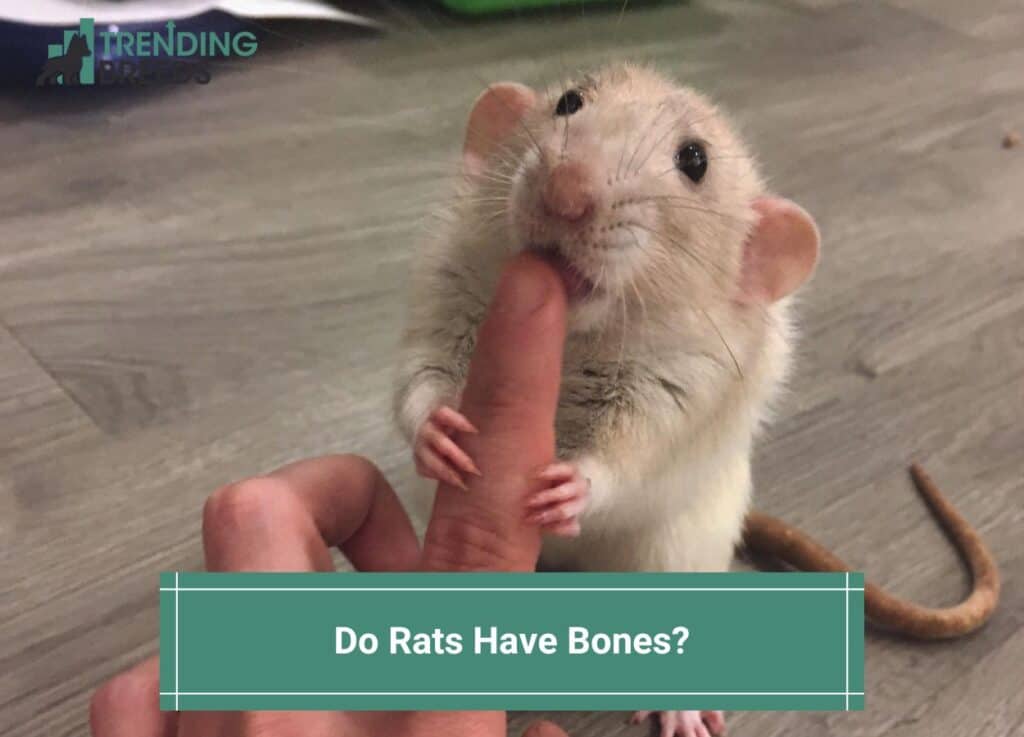
Rats are often famous for lacking bones, which is a common misconception. This belief stems from their ability to navigate through narrow openings. So, does a rat have bones?
Rats are vertebrate animals possessing a skeletal system that includes a spinal cord and bones joined by cartilage.
Furthermore, rats do not have pliable or collapsible skeletons. Instead, like humans, rats have stiff bones attached to the joints via cartilage.
Read on to learn more.
Before you scroll further down this guide, check out these other rat-related articles: How Long Can a Rat Live Without Food? and Do Rats Play Dead?.
Table of Contents
How Many Bones Do Rats Have?

It is indisputable that rats possess an endoskeleton. Yet, surprisingly, despite their diminutive stature, rats have a more significant number of bones in their body than humans.
Specifically, they have 223 bones, which exceeds the human bone count by 17.
Bones In a Rat’s Tail

Do rats possess bones in their tails?
Yes they do! Rat tails contain bones dispersed throughout their length. Essentially, a rat’s tail comprises an inner layer of bones encased by tendons and covered by skin.
Moreover, rats lack sensory perception in their tails. However, this claim is erroneous since rats can detect touch and pain in their tails.
In addition, their tails are highly sensitive and play a role in temperature regulation.
Backbone Of a Rat

There is yet another widespread misconception that rats lack a spinal column, which is utterly untrue.
Rats undeniably possess a backbone. The reason for this misunderstanding is the rats’ ability to squeeze through narrow gaps.
Nonetheless, the reason why rats can maneuver through tiny openings is not because of the absence of their spine but rather their spine’s unique evolutionary adaptation.
Their spinal column has evolved to enable them to enter holes the size of their head.
Are Their Skeletons Flexible?

Have you ever wondered how rats could fit through such tiny holes? Typically, rats can squeeze through spaces as small as a quarter, less than an inch in diameter!
The extent to which a rat can compress its body depends on the size. Smaller rats can make themselves even tinier, which makes them a tricky pest to catch in homes.
Contrary to rumors and myths, rats do not have collapsible skeletons. Instead, their bones are dense and rigid, and they can break under pressure like any other animal.
The reason rats can move around undetected in homes is not due to flexible or bendable bones. If their bones were loose, they could easily escape traps.
The only form of bone flexibility that rats have is in their joints. Like humans, rats have cartilage in their joints that cushion their bones and allow full mobility.
To fit through small openings, rats stretch their bodies and use their natural flexibility to make themselves as compact as possible.
How Do Rats Squeeze Through Small Holes?

Many people wonder how rats can navigate through small gaps when they have rigid and inflexible bones.
The answer lies in their physical structure. Upon close observation, one can discern that rats have a highly flexible elongated, and cylindrical body shape.
This physical composition allows them to contort their bodies and wriggle through narrow openings.
Furthermore, this maneuverability is inherent to rats’ lifestyles. As burrowing animals, they use traversing tunnels and tight spaces regularly. Their whole lives revolve around navigating through confined areas.
It is worth noting that not all rats possess this skill. Only those with a healthy physique can squeeze through tiny holes.
Rats that are overweight tend to accumulate excess weight in their abdominal region, making their girth wider. Consequently, regardless of their hard work, they need help to fit themselves through narrow openings.
Rats Can Get Stuck

It is indeed possible for rats to get trapped in small openings, as has happened before. Although rats have lithe, lengthy bodies, they can still get stuck in holes, especially when reaching their favorite foods.
When rats run away, they may misjudge the size of a hole and attempt to force themselves through it, only to become stuck in the middle.
In other cases, overweight rats may overestimate their height and believe they can fit through a small opening.
Despite their elasticity and form, rats can remain stuck briefly. However, they can usually wiggle themselves out of the opening within a few moments and move on to the next one.
Human intervention may be necessary if they cannot free themselves due to a miscalculation or other reasons.
Rats Can Get Into Your House

Rats are curious pests and use any accessible entry point to infiltrate your home, including vents and wall gaps.
They can squeeze through even the tiniest of openings, and most people are unaware that they can hold their breath for up to 30 minutes, making pipelines and plumbing suitable entry points.
If you find yourself amid a rat infestation, you can use rat poison or traps to eliminate them. In more complex situations, an exterminator may be necessary.
It’s crucial to thoroughly inspect your home, searching every nook and cranny for even the slightest opening.
It’s essential to cover or seal any potential entry points you discover. Keep your home’s doors open, and keep composting containers and trash cans tightly covered. Consider using wire mesh, as previously recommended.
The first step in rodent prevention is to rat-proof your home. Then, you’ll have less to worry about if they can’t get in.
But, unfortunately, rats will seize any opportunity to enter your home, often searching for shelter and their next meal.
FAQs About Rats And Their Bones

How many bones does a rat have?
A rat has approximately 206 bones, although the number may vary slightly depending on the individual rat’s anatomy.
The skeletal structure of rats is similar to that of other mammals, including humans, with bones in the skull, spine, ribcage, limbs, and tail.
However, rats have unique adaptations, such as their flexible spine and elongated tail, allowing them to move quickly and navigate tight spaces.
How do rats fit through small cracks?
Rats can fit through small cracks and gaps because of their highly flexible bodies and bone structure.
In addition, they can squeeze their bodies through openings that may seem too small by contorting their shape and compressing their organs.
Rats also have collapsible rib cages that allow them to flatten their bodies, making it easier to squeeze through tight spaces.
In addition to their physical flexibility, rats are highly skilled at identifying and exploiting small openings.
They have a strong sense of touch and can detect changes in air currents, temperature, and humidity that may indicate the presence of a door.
Once they find a potential entry point, they use their sharp teeth and powerful jaws to chew and gnaw through obstacles.
Rats are highly adaptable and resourceful animals well-suited to living in many environments, including urban and suburban areas, where they can find ample opportunities to exploit small openings and gaps in buildings and other structures.
Can rats collapse their skeleton?
No, rats cannot collapse their skeleton. While highly flexible rats can contort their bodies to fit through small openings, their skeletal structure remains intact.
Rats have a complex musculoskeletal system that allows them to move with agility and speed, but their bones are solid and cannot collapse.
However, rats have a unique adaptation called a “hinge joint” in their skulls, allowing them to compress their heads and squeeze through narrow openings.
This hinge joint has a flexible joint between the bones in the skull that allows the bones to shift and overlap, reducing the head size and allowing rats to fit through openings much smaller than their usual size.
That is one reason rats can squeeze through tiny cracks and gaps that might seem impossible.
While rats cannot collapse their skeleton, they have many other adaptations that make them highly adaptable and able to survive in various environments.
Do rats have no spine?
No, rats have a spine, an essential part of their skeletal system. Like all mammals, rats have a backbone, which comprises a series of small bones called vertebrae that run from the base of the skull to the tip of the tail.
The spine serves as the main support structure for the rat’s body, protecting the spinal cord and providing a framework for the attachment of muscles and other tissues.
Rats are known for their flexibility, and their spine plays a key role. Their highly flexible spine allows them to move quickly and easily through tight spaces and narrow openings.
Additionally, rats have long, slender, highly flexible tails that help them maintain balance and agility as they move around.
In summary, rats have a spine, an essential part of their skeletal system that allows them to move with agility and flexibility.
Does a rat have bones?
Yes, rats do have bones. Like all mammals, rats have a complex skeletal system that provides support and protection and allows movement. Rats have over 200 bones in their skull, spine, ribcage, limbs, and tail.
The bones of a rat are made up of a hard outer layer called the cortical bone and a spongy inner layer called the trabecular bone.
The bones also comprise living tissue, including bone cells, blood vessels, and nerves, allowing growth and repair.
The skeletal system of rats plays a vital role in their survival, providing support for their body, protecting their organs, and allowing them to move with speed and agility.
Rats also have sharp teeth and powerful jaws, specialized bones that have evolved to help them gnaw through rigid materials and extract food.
The Answer For The Question: Do Rats Have Bones?

Rats do indeed have bones, contrary to popular belief. Rats are vertebrate animals possessing a skeletal system similar to humans that includes a spinal cord and bones joined by cartilage.
Their ability to navigate through narrow openings is due to their physical structure, which comprises a cylindrical, elongated, and flexible body shape.
Rats’ bones are rigid and dense, allowing full mobility, with the only form of bone flexibility in their joints.
While rats can squeeze through spaces as small as a quarter, overweight rats may need to help fit through narrow openings.
As a result, it is possible for rats to get trapped in small gaps, and human intervention may be necessary.
If you find yourself amid a rat infestation, it’s essential to cover or seal any potential entry points and consider using wire mesh to eliminate them.
If you find this guide, “Do Rats Have Bones,” informative and helpful, you can check out these other rat-related articles from our team:
You can learn more about rats by watching “All You Need to Know About RATS” down below:




